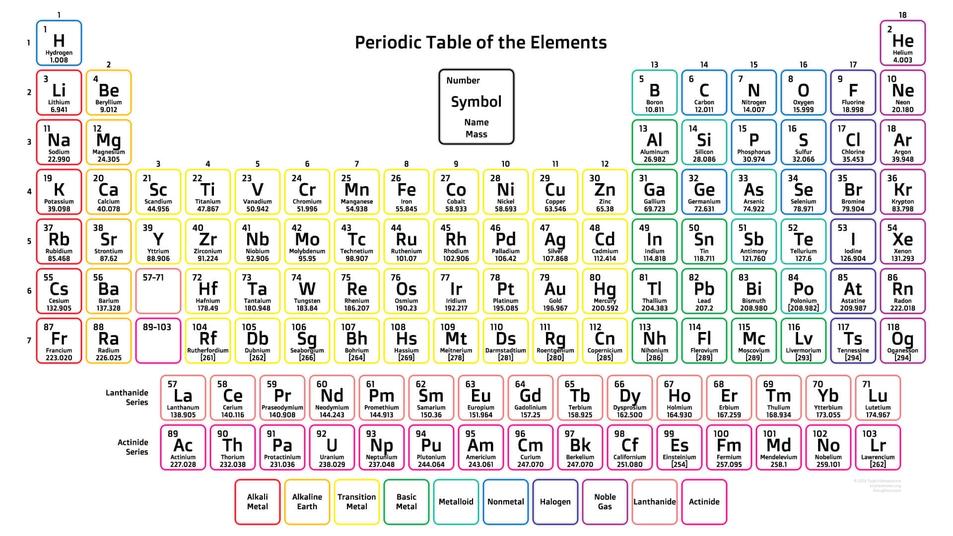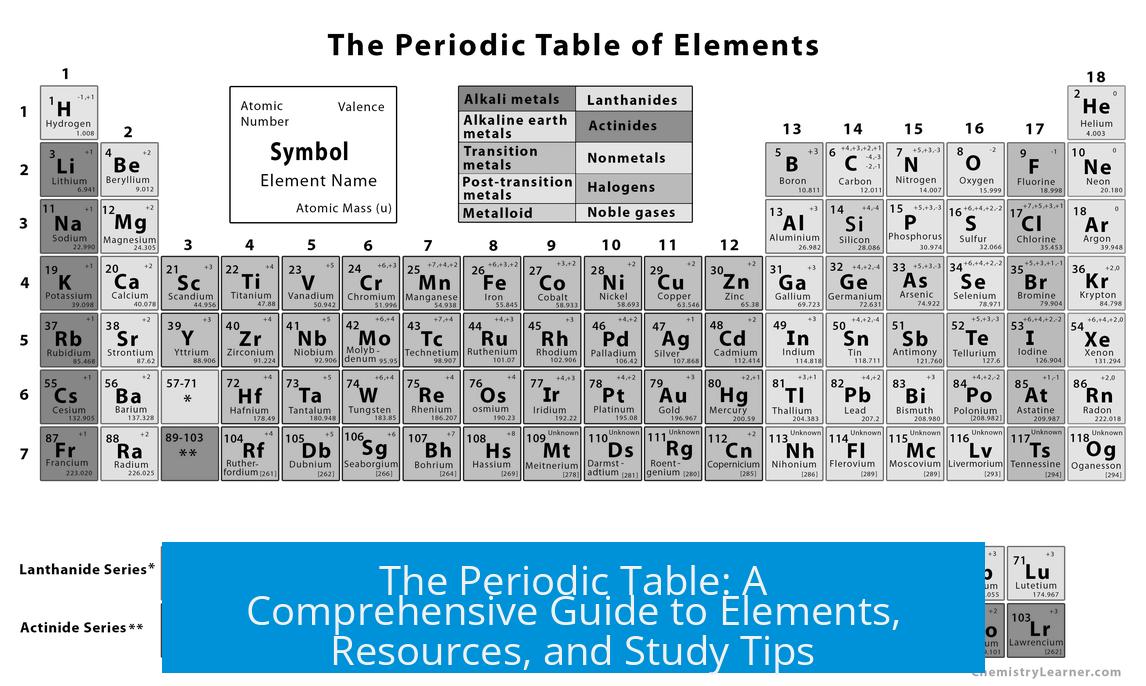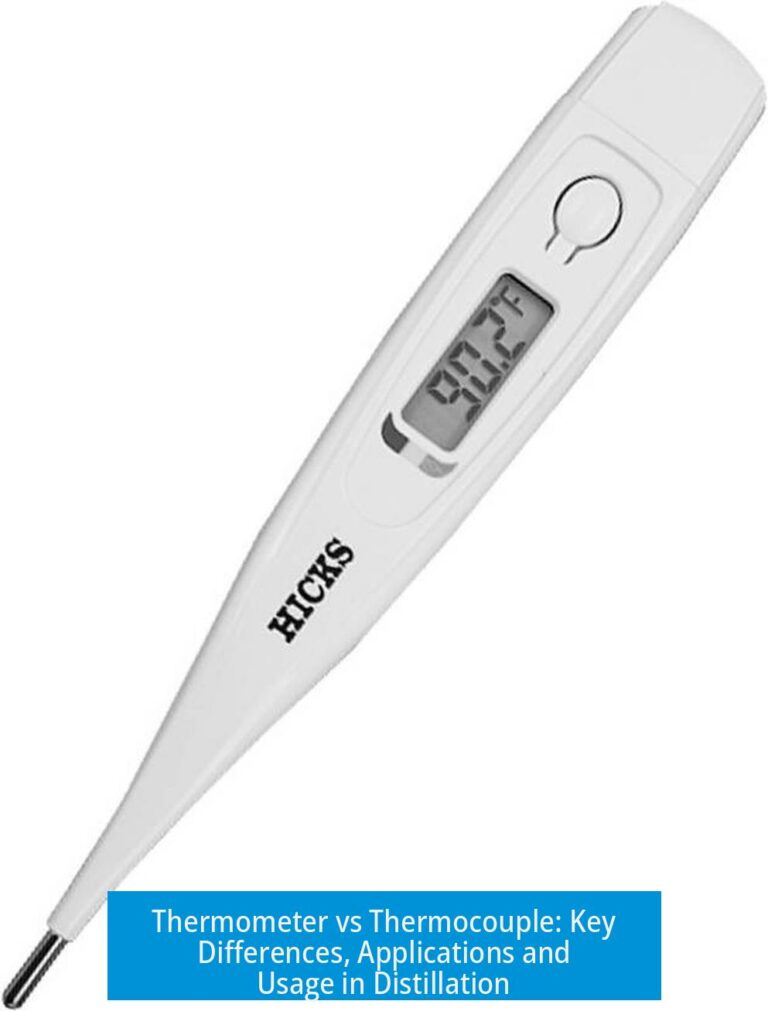Understanding the Periodic Table: Essential Guide and Recommended Resources
The periodic table is a fundamental tool in chemistry that organizes all known chemical elements based on atomic number, electron configuration, and recurring chemical properties. It allows students, educators, and professionals to predict element behavior and understand relationships among elements efficiently. This article explores the structure, features, study recommendations, and popular periodic table resources to optimize learning and usage.

Structure and Purpose of the Periodic Table
The periodic table arranges elements in rows called periods and columns known as groups or families. Each element is positioned by increasing atomic number, which correlates with the number of protons in its nucleus. This organization reveals periodic trends, such as atomic radius, electronegativity, and ionization energy, that change predictably across periods and groups.
- Groups: Vertical columns, elements share similar valence electron configurations and chemical properties.
- Periods: Horizontal rows, elements have the same number of electron shells.
- Blocks: Regions defined by electron subshells (s, p, d, f blocks).
This systematic layout helps users understand element properties, predict reactions, and classify metals, nonmetals, and metalloids.
Popular Periodic Table Resources: Interactive and Printable Options
Ptable.com
Ptable.com offers an interactive and detailed periodic table widely appreciated for its depth. Users can explore properties like atomic mass with high decimal precision, electron configurations, isotopes, and radioactivity. Its visual interface offers enhanced learning with real-time information updated regularly.
User feedback highlights easy navigation and comprehensive data, making it a go-to for students requiring more than basic information.
Royal Society of Chemistry (RSC) Periodic Table
The RSC periodic table provides an authoritative resource with clean design and scientific accuracy. Its mobile app version for iPad and phones enhances accessibility for on-the-go learning. It succinctly presents useful properties such as atomic weight, density, and melting points without overwhelming beginners.
PubChem Periodic Table
PubChem’s periodic table stands out for its color coding, which helps differentiate element groups visually. It is favored by many users for its vivid presentation and straightforward interface, aiding intuitive recognition of element categories such as noble gases and halogens.
IUPAC Periodic Table
The International Union of Pure and Applied Chemistry (IUPAC) provides the official periodic table, which serves as a standard reference for naming elements and structure. It ensures global consistency in element data, including newly discovered elements.
Additional Resources
- PeriodicTable.com: Offers various interactive features and educational materials.
- ScienceAlert Article on Alternative Periodic Tables: Explores creative periodic table layouts, expanding understanding of element relationships beyond the traditional format.
- Google Interactive Periodic Table: Simple visualization accessible via search, highlighting radioactive elements with blue glow and element images.
- Sargent Welch Table: Includes many properties consolidated on one chart, beneficial for comprehensive review.
- American Chemical Society (ACS) Table: Presents essential information without extraneous details, useful for exam preparation.
Key Features to Consider When Choosing a Periodic Table
Selecting the right periodic table depends on the user’s purpose, whether for study, teaching, or reference.
Atomic Mass Precision
High precision in atomic mass is crucial for accurate calculations. For instance, atomic mass for oxygen is sometimes listed as 15.9998 instead of a rounded 16, which affects stoichiometric computations and laboratory work.
Color Coding and Group Identification
Color differentiation facilitates quick recognition of element groups such as alkali metals, alkaline earth metals, halogens, and noble gases. Tables like PubChem’s employ vivid colors that improve usability for beginners and experts alike.
Radioactivity Indicators
Highlighting radioactive elements with a distinct visual cue, such as a blue glow, enhances safety awareness and understanding of element stability, especially useful in nuclear chemistry and related fields.
Visualization of Atomic Structures
Some interactive tables include images or models of atomic structures. These visual aids help grasp concepts such as electron orbital shapes and element isotopes.
Comprehensive Data Inclusion
Highly detailed tables, like the Sargent Welch periodic table, present multiple properties such as melting point, density, and electronegativity on a single chart. This consolidation supports advanced study and research.
Focus on Relevant Information
Tables designed for classroom use, such as those from the ACS, omit less critical data in favor of exam-relevant facts. This helps students focus on what they need to remember without distraction.
Advice for Beginners: How to Use and Study the Periodic Table Effectively
Start with the Exam-Approved Periodic Table
Students should begin learning with the periodic table allowed in their exams. This ensures familiarity with the format and data presentation they will encounter during assessments.
Focus on Trends Instead of Memorizing Details
Rather than memorizing all element properties, understanding periodic trends such as atomic radius decrease across periods or ionization energy behavior aids long-term comprehension and problem solving.
Use Simple and Clear Tables
Beginners benefit from straightforward tables that include group labels, colored categories, and the stair-step line separating metals from nonmetals. Complexity can be overwhelming when starting out.
Memorization Experience and Reinforcement
Some learners find memorizing a specific periodic table layout helpful for retention. Repeated use and review help embed the information into memory.
Table Comparison: Selection for Different Needs
| Periodic Table | Main Feature | Best For | Link |
|---|---|---|---|
| Ptable.com | Highly interactive, detailed info | Students & researchers seeking depth | Visit |
| Royal Society of Chemistry | Authoritative, mobile app | Mobile users & academic reference | Visit |
| PubChem | Vivid color coding | Visual learners | Visit |
| ACS Periodic Table | Concise exam info | Exam preparation | Visit |
| Sargent Welch | Most properties on one chart | Comprehensive study | Physical copy preferred |
Additional Tools and Customization
Advanced users may prefer customizable resources, such as the Google Sheets periodic table created to include missing data and tailored features. This allows personalization for specific research or teaching purposes.
Various PDFs and print-ready charts are also available, such as the Tsigaridisjunior PDF table, useful for offline use and annotation.
Key Takeaways
- The periodic table organizes elements by atomic number and properties, revealing important chemical trends.
- Use interactive sources like Ptable.com for in-depth exploration and visualization of element data.
- Beginners should focus on simplified, exam-approved tables to build foundational understanding.
- Color coding, atomic mass precision, and radioactivity indicators enhance usability and safety awareness.
- Advanced tables such as Sargent Welch provide comprehensive property data in a single view.
- Memorization benefits from working consistently with a preferred table but understanding periodic trends is more valuable long-term.
The Periodic Table: Your Ultimate Guide to Elements and Beyond
What is the periodic table? It’s the master chart of all chemical elements, arranged by atomic number and grouped by shared properties. This neat grid is more than just colorful boxes; it’s the key to understanding chemistry’s language. But with so many versions out there, which one should you use? And how do you make the most of it?
Let’s take a deep dive into the world of periodic tables, exploring the best versions, smart usage tips, and fun facts that make this chart more than a boring school tool.
Choosing the Right Periodic Table: More Than Just a Reference
First up, the classic question: which periodic table should I pick? The truth is, there’s a buffet of options. Each is tailored to different needs, preferences, and levels of depth.
Ptable.com scores big for its interactive setup and rich database. Users love it because it packs way more info than the traditional tables. Having it bookmarked means you’re set for answers on the fly. It’s like having a chemistry professor in your browser.
For those who crave a sleek, mobile-friendly experience, the Royal Society of Chemistry (RSC) Periodic Table shines. It’s especially popular on iPads and phones, combining portability with solid info.
If colors matter to you, PubChem’s periodic table offers a visually appealing palette that stands out. The way elements light up can make spotting patterns a breeze.
Want the official take? The IUPAC periodic table is the gold standard for element names and symbols—authoritative and up to date.
For a no-frills approach loaded with just the essentials, the American Chemical Society (ACS) periodic table offers relevant info without the clutter. It helps keep students focused on what matters, avoiding unnecessary confusion.
And finally, nostalgia fans swear by the Sargent Welch periodic table, a chart packed with multiple properties on a single sheet, perfect to understand element traits at a glance.
Beginner’s Advice: What Matters More Than Memorization?
New to chemistry? Here’s a golden tip: stick with the periodic table allowed in your exams. That’s your right hand for practice. No need to chase fancy tables with shiny bells and whistles just yet.
The larger secret? Don’t try to memorize every single number or satellite fact. As a seasoned chemistry student at a top university points out, “familiarize yourself with trends, not details.” Understanding why elements behave more like their group neighbors than random atoms beats rote memory any day.
A simple periodic table with colored groups, clear halogen labeling, and the staircase line dividing metals and non-metals usually does the job. Overcomplicating early on only muddies the waters.
Features That Make a Periodic Table Worth Your Attention
Let’s talk specifics. What should a high-quality periodic table include?
- Atomic Mass Precision: Some prefer atomic masses with four decimals like Oxygen at 15.9998. It’s nitpicky, sure, but nice to have precision when your lab demands it.
- Color Coding: PubChem’s bold colors win fans. Groups distinguished by color help your eyes spot families and trends instantly.
- Radioactivity Indicators: Tables that glow radioactive elements in blue make spotting unstable elements intuitive and safe.
- Visualizing Atomic Structures: Google’s interactive table shows what each element looks like—making abstract concepts a bit more real.
- Multiple Properties: Remember Sargent Welch? Its chart isn’t a minimalist’s dream but packs in melting points, electronegativity, and other key properties on one page.
- Organization & Relevance: The ACS’s table cuts clutter, giving pertinent info only. Busy learners will appreciate staying organized without overflow.
Beyond the Chart: Study Tips and Fun Resources
Memorizing the periodic table can feel like an uphill climb. But some find joy in the challenge: “I learned it by heart so I really like the one stuck in my head,” says a student. Mnemonics, flashcards, and apps help here.
Interested in quirky periodic tables? Try ScienceAlert’s article on alternative periodic tables. It’s proof that even a 150+ year-old chart can inspire new designs and perspectives.
Looking to customize? Some chem enthusiasts build their own tables on Google Sheets, adding missing elements or tailored data. This level of control can transform study sessions from tedious to engaging.
Don’t forget random inspiration—sometimes a quick Google image search or browsing chemistry forums like Reddit’s element colors thread can spark curiosity and provide unexpected insights.
Wrapping It Up: Why All This Matters
The periodic table isn’t just a list. It’s the compass guiding chemists through the natural world’s building blocks. Choosing the right version, focusing on trends, and using tools that fit your style make learning chemistry manageable and even fun.
So, next time you open your chemistry book or Google “periodic table,” remember: the BEST table is the one that *helps* you understand, not the one that overwhelms you with unnecessary trivia. Whether it’s interactive, colorful, simple, or packed with data, your perfect periodic table awaits.
Which periodic table version do you swear by? Or do you have a unique way of remembering element details? Share your tips and stories—because even the periodic table isn’t set in stone!
What are some recommended interactive periodic tables for learning?
Ptable.com offers an interactive table with extra info. Google’s periodic table shows element visuals. The Royal Society of Chemistry also has a mobile-friendly version. These help explore elements beyond static charts.
Which periodic table is best for exam use and why?
Use the periodic table allowed in your exam. It’s best to practice with the same one. Focus on understanding trends instead of memorizing every detail. Simpler tables with colored groups and labeled halogens often work well.
How important is atomic mass precision on periodic tables?
Some prefer atomic masses with four decimals, like 15.9998 for oxygen, instead of rounded numbers like 16. More precision helps in accurate calculations, useful in higher-level chemistry studies.
What features make the Sargent Welch periodic table special?
It includes many properties on a single chart, combining organization with relevant info. Users say it helps keep data clear without extra, unnecessary details. That makes it favored for detailed reference.
How is radioactivity shown on certain periodic tables?
Some tables use a blue glow or color highlight to show radioactivity. This helpful visual cue points out unstable elements quickly, aiding users in identifying them at a glance.
What should beginners focus on when using periodic tables?
Beginners should look for tables that clearly show groups and periods with color coding. Labeling halogens and including a stair-step line separating metals helps understand elemental behavior without overload.





Leave a Comment